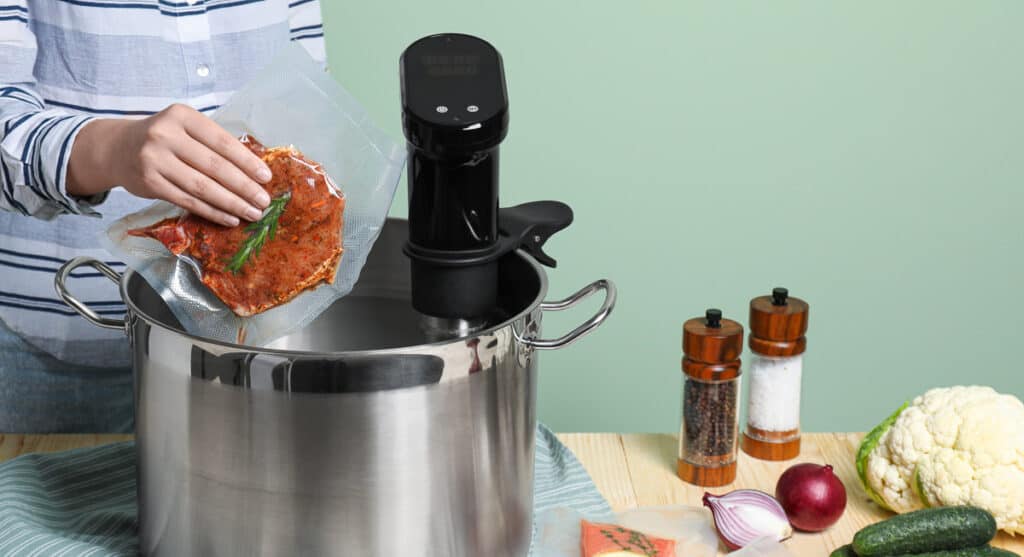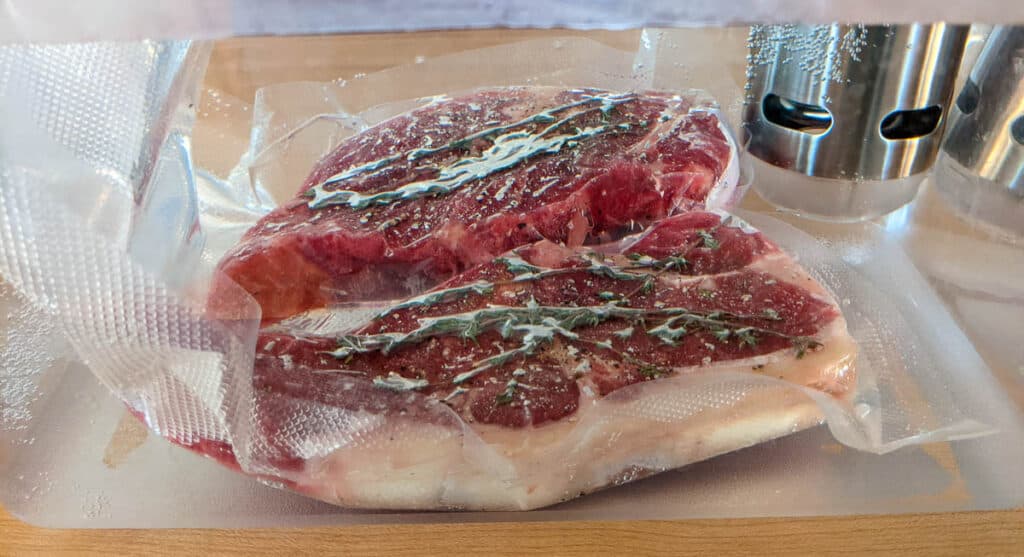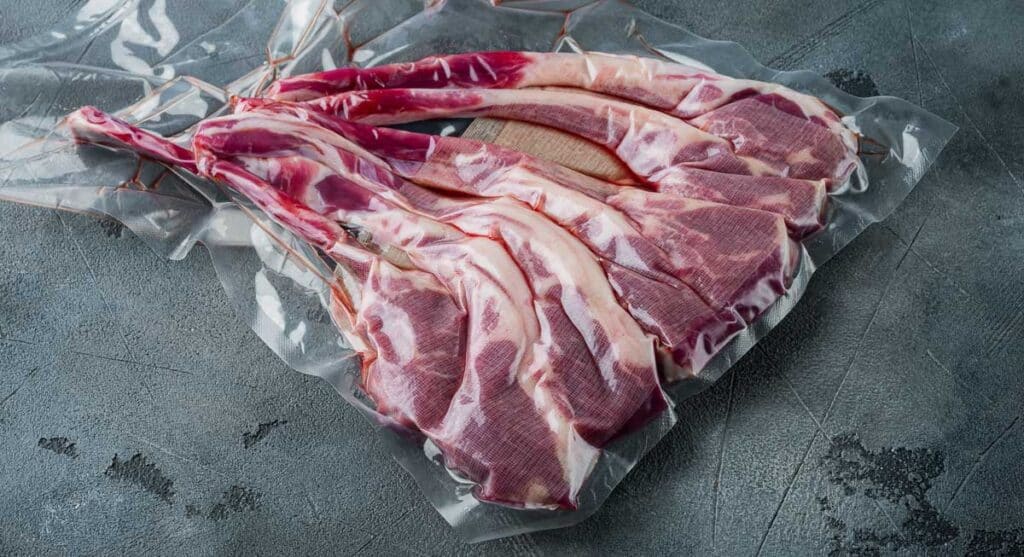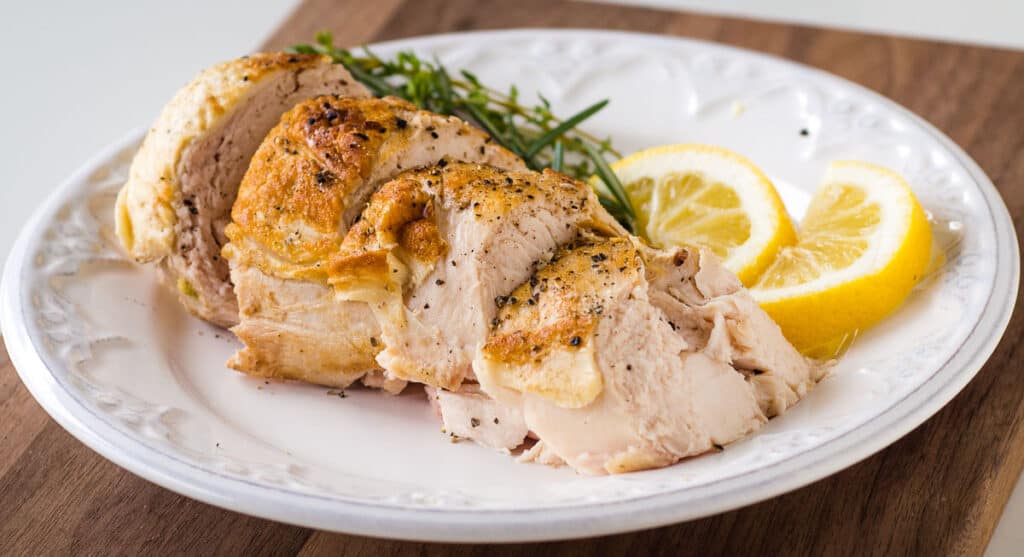Sous vide cooking is a culinary technique that sounds complicated but is quite simple. Imagine cooking food to the perfect level of doneness, tender and full of flavor, every single time. Sous vide offers this level of control.

Sous vide cooking involves sealing the food in a bag — often vacuum-sealed — then submerging it in a water bath at a precise temperature. This method provides exceptional control over temperature, which is key to preparing cooked meals just right.
The beauty of this technique lies in its consistent results and the near impossibility of overcooking. Whether preparing a steak, vegetables or even custards, sous vide cooking doesn’t require much hands-on time. If you’re a home cook looking to step up your culinary game, sous vide might be the kitchen technique for you.
Basics of sous vide cooking
Sous vide cooking allows for precision temperature control to achieve consistent results. It’s a popular method for both home cooks and professional kitchens.
Sous vide cooking explained
Sous vide is a cooking method where food is sealed in a bag and cooked in a temperature-controlled water bath. Sous vide means under vacuum in French, indicating that food is typically prepared in a vacuum-sealed bag. This technique ensures even cooking and moisture preservation.
Equipment needed
A sous vide machine, also known as an immersion circulator, is an essential piece of equipment for this technique. This machine maintains the water at a precise temperature by heating and circulating the water.
Food-grade plastic bags, vacuum seal bags and a water bath container large enough to hold the food are also necessary. The water bath can be a large pot, cooler or dedicated plastic sous vide container.

Advantages of sous vide cooking
The sous vide method offers precision. The water bath’s temperature is controlled and doesn’t fluctuate like a traditional oven or stove.
- Consistency: Reliable, repeatable results are achieved every time. The steak comes out medium-rare from edge to edge without the risk of overcooking.
- Taste: Meats retain natural juices, while vegetables emerge with a vibrant texture and flavor, as nutrients are not lost to the cooking water.
- Tenderizing: Tough cuts of meat become tenderized over the prolonged cooking process.
- Temperature retention: Once the dish is in the water bath, it reaches the target temperature and holds it. This allows flexibility in cooking time and more time to focus on other tasks.
- Meal planning: Prepare meals in batches and store them in the fridge or freezer. Then, reheat them in a sous vide for meals throughout the week.
“I enjoy using my sous vide. It makes the most tender meat I’ve ever had, even when I don’t use the most expensive cut. It is such a great way to infuse flavors throughout the food, no matter what you make. I use it for everything from egg bites at breakfast to molten chocolate cake for dessert.”
— Michelle Price, Honest and Truly
Disadvantages of sous vide cooking
While there are many advantages, this cooking method has some drawbacks. It is not the best method for every situation or type of food.
- Time-consuming: Sous vide cooking takes longer than traditional methods. For example, a sirloin steak could take an hour to reach the desired level of doneness instead of minutes on a grill.
- Advanced planning required: Because of the longer cooking times, planning meals well in advance is necessary. Last-minute cooking is less feasible.
- Equipment cost: The initial setup for sous vide cooking requires buying a precision immersion circulator that maintains accurate temperatures to avoid undercooked or overcooked food.
- Sustainability: The process uses plastic bags and improper disposing of these bags has a negative environmental impact.
“The entire concept of spending money on plastic just to throw it away after I cook my food in it feels a bit absurd considering the abundance of microplastics in our environment. It just seems so wasteful.”
— Renee Gardner, Renee Nicole’s Kitchen

Preparing a sous vide meal
There are four steps to preparing a sous vide meal. First, the ingredients must be seasoned and then sealed in a bag. Then, the food cooks in the water bath for the amount of time called for by the recipe. Finally, most sous vide meals require searing after cooking.
Seasoning and prepping ingredients
Flavors can intensify during the sous vide process, so be careful not to over-season. In addition, consistently sized ingredients cook more evenly.
- Meat: Season with salt and any preferred spices. For added flavor, consider marinating for a few hours beforehand.
- Vegetables: Light seasoning works well.
- Aromatics: Adding fresh herbs, garlic or citrus zests can infuse the dish with deeper flavor profiles.
Sealing the food
A vacuum sealer simplifies the sealing process. When using a vacuum sealer, arrange food in a single layer to allow for even heat distribution and avoid overfilling the bag.
The water displacement method works when a vacuum sealer is not available. For this method, place the food in a resealable food-grade plastic bag.
Keep the bag slightly unsealed and slowly lower it into the bath. The water pressure will push out excess air. Seal the bag when all the air is gone.
Cooking the food
Each sous vide recipe will specify the cooking temperatures and times necessary. Times can range from less than an hour for vegetables to days-long cooks for some large roasts.
Ensure the food is fully submerged in the preheated water bath and that the bag is not blocking the water from circulating for even cooking. Use clips to attach the bag to the side of the container if necessary to keep it submerged and in place.
Filled with appetizers, salads, sides, mains and desserts, Food Drink Life's cookbook will become your favorite!
- Easy and delicious recipes from a variety of top chefs and recipe developers.
- Bright, colorful pictures on every page.
- Printer-friendly recipes that you can download instantly to your device.
- Printable shopping list and a kitchen conversion sheet.

Finishing techniques
Most meats benefit from searing after the dish comes out of the water bath. Searing can take a sous vide meal from cooked to restaurant quality.
Searing activates the Maillard reaction, which creates a deliciously caramelized crust that is missing from the sous vide process. Follow these steps for a great sear.
- Dry the meat thoroughly with paper towels. Surface moisture inhibits browning.
- Preheat a skillet or grill to a high temperature before adding the meat.
- Use a high-smoke-point oil, such as avocado oil, to avoid burning.
- Sear quickly, typically for 1 minute per side, to avoid overcooking the interior.
Summing up
Sous vide cooking is a method that stands out for its precision, consistency and ability to lock in flavors and moisture. By controlling the temperature to such exact degrees, chefs and home cooks alike can achieve results that are difficult, if not impossible, to replicate with traditional cooking methods.
Whether preparing a succulent steak, tender vegetables or perfectly cooked chicken breast, sous vide cooking offers an easy path to excellence. As more people discover the benefits of sous vide, it continues to evolve with new recipes, techniques and dedicated equipment, making it an increasingly accessible option for everyday meals.
Anne Jolly is the creator of the food blog Upstate Ramblings. She loves to cook with gadgets like an air fryer, sous vide or pressure cooker. In her free time, she enjoys hiking, reading, knitting and spending time with her three kids.
